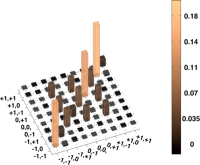Menu
Fundamentals of quantum mechanics
Complementarity & bound entanglement

In a collaboration with Beatrix Hiesmayr (Vienna) we use the high-dimensional quantum entanglement provided by transverse-mode entangled photons (spatial entanglement) to study yet unexplored quantum states. As a first step, we have verified experimentally “bound entanglement” of two photons. Bound entanglement does not exist between pairs of conventional polarization-entangled photons, as each of such a pair lives in an only 2D Hilbert space. True bound entanglement can appear only in higher-dimensional systems, such as orbital angular momentum entangled twin photons.

It is very important to study this, because there is a connection to entanglement distillation: Until 1998 it was thought that all partially entangled systems can be “distilled” (which means in the simplest form to modify quantum correlations by changing the detection probability for certain states) into nearly pure-entangled systems; only these are easily usable in quantum information applications such as cryptography. But it was found that there are states for which no (LOCC) entanglement distillation method is possible, but which are still quantum entangled: Those are called “bound”.

We used a method where we can explore efficiently many quantum states, and we found that a significant fraction of all entangled states are actually bound entangled! One specific section through the 3×3 dimensional Hilbert space is shown in the picture.
Complementarity Reveals Bound Entanglement of Two Twisted Photons, New J. Phys. 15, 083036 (2013), preprint: Arxiv:1212.5046
Mutually Unbiased Bases and Bound Entanglement, Phys. Scr. T160, 014017 (2014), preprint: Arxiv:1309.2271
